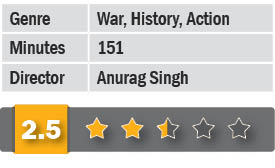 “Tum log humsey better hotey toh tum hamaarey ghulaam nahi hotey,” says gora British army officer, Lawrence (Edward Sonnenblick) to his subordinate Havaldar Ishar Singh (Akshay Kumar). And this, after the Havaldar demonstrated raw courage in the face of extreme danger, by jumping to the rescue of an Afghan woman about to be beheaded as she was unwilling to live with her brutal husband.
“Tum log humsey better hotey toh tum hamaarey ghulaam nahi hotey,” says gora British army officer, Lawrence (Edward Sonnenblick) to his subordinate Havaldar Ishar Singh (Akshay Kumar). And this, after the Havaldar demonstrated raw courage in the face of extreme danger, by jumping to the rescue of an Afghan woman about to be beheaded as she was unwilling to live with her brutal husband.
‘Kesari’ alludes to the colour of the paghdi (turban) which symbolises gallantry and fortitude. For this act of defiance, the protagonist is dispatched to the inactive Saragarhi Fort, which has the 36th Sikh Regiment comprising 20 disorganised Sipahis, located between Gulistan and Lockhardt Forts in the Northwest Frontier Province. In defending the Fort, the film attempts to recreate history’s second-most historic and mismatched battle, on 12 September 1897, against 10,000 bloodthirsty Pashtuns.
Director Anurag Singh would have been in familiar surroundings, given the theme and the characters. But the script seems flawed and the humongous dialogues, at inopportune moments, take away from what could have been an epic war film. Sample this – the marauding warriors are at the doors, literally, of the Fort, when one of the 36th Regiment would adjust his paghdi or break into a song (of course, the Afghans would patiently wait for the director’s orders to resume hostilities!), or Ishar Singh’s single war drum drowning out the deafening war drums of the entire opposing army. Or an injured Ishar Singh with just a sword taking on a hundred enemies, some of them with rifles (who obediently wait for the action director’s orders to use them). Contrived patriotic cliches, and fleeting flashbacks with his beloved (Parineeti Chopra) fail to elevate this war historical. The few and abrupt scenes of a transvestite sniper are needless. Shot in Wai (Maharashtra), and in Himachal Pradesh, the cinematography by Anshul Chobey brilliantly recreates Pashtun regions. Subrata Chakravorty’s production design is noteworthy.
- Parsee Gym Retains Supremacy In 7th Late Manek Golvala T10 Cricket Cup - 13 April2024
- Parsee Gym Holds 9th All-Parsee TT Tourney - 6 April2024
- Parsee Gym Holds Gala Jamshedi Navroze Celebrations - 30 March2024
